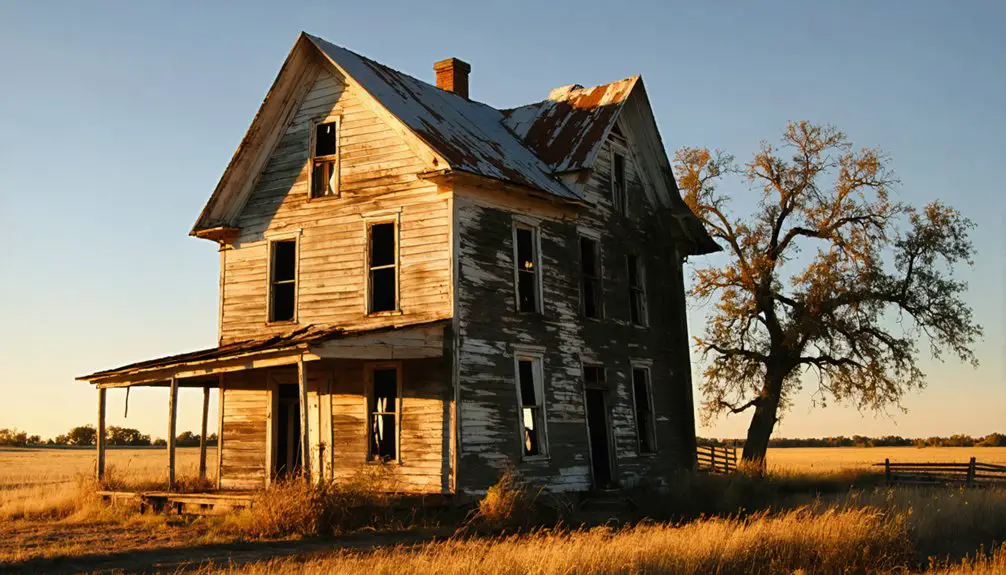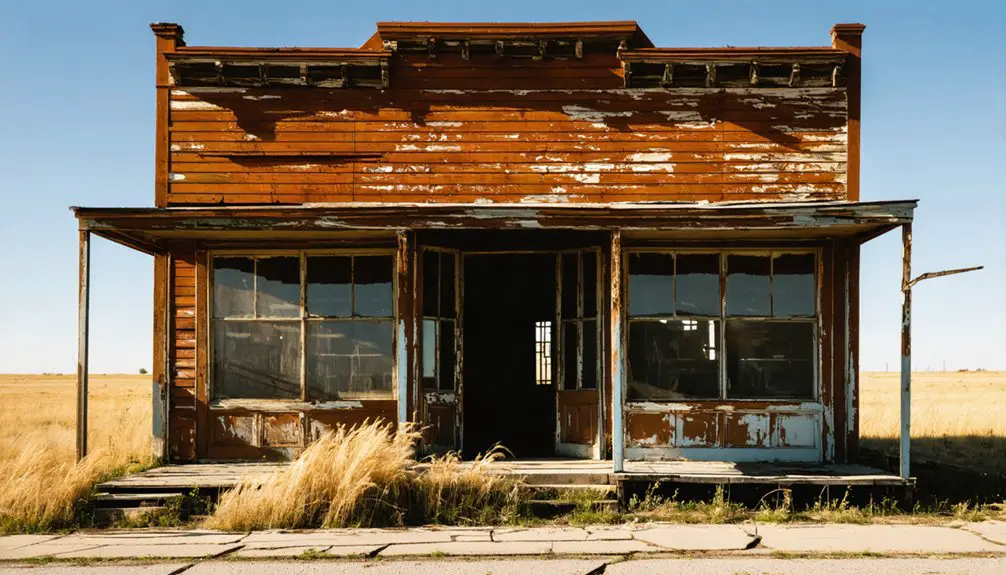You’ll find Parkland’s ghost town story began with Oklahoma’s 1891 Land Run, when settlers established this frontier community near important railroad connections. The town thrived initially with a post office and regional trade networks, but a devastating tornado struck on May 30, 1897, killing two residents and destroying essential infrastructure. Economic struggles and population exodus followed, leading to the post office’s closure by 1918. The quiet fields today hold countless untold tales of frontier dreams and stark realities.
Key Takeaways
- Parkland was established during Oklahoma’s 1891 Land Run and had a post office established in 1894 under postmaster McShelly Fishback.
- A devastating tornado struck on May 30, 1897, killing two residents and causing widespread destruction that accelerated the town’s decline.
- Economic challenges and population exodus followed the tornado, with many businesses relocating to nearby Kendrick.
- The post office closure in 1918 marked a significant milestone in Parkland’s transformation into a ghost town.
- The land eventually returned to agricultural use, with few physical remnants remaining of the former frontier community.
Early Settlement and Land Run Origins
Before Parkland became a ghost town, the land it occupied was part of the vast territory controlled by Native American tribes in present-day Oklahoma.
The area’s land ownership shifted dramatically following the 1866 treaties, when the U.S. government purchased large portions from the tribes, creating the “Unassigned Lands” that would later be opened for settlement.
You’ll find the roots of Parkland’s story in the Oklahoma Land Rush of 1889, when approximately 50,000 settlers raced to claim their piece of these two million acres.
The settlement patterns that emerged from this historic event transformed the region overnight, as “Boomers” and “Sooners” competed for prime locations.
While some secured legitimate claims, others gained advantages through illegal early entry, setting the stage for conflicts that would shape the area’s development.
The transformation was especially dramatic in places like Guthrie’s population, which exploded from just 10 people to 15,000 in a single day.
The land that would become Lincoln County was officially opened for settlement during the Run of 1891, bringing a new wave of pioneers to the region.
The Rise and Fall of a Frontier Community
You’ll find Parkland’s origins in the 1891 Land Run, when settlers established this small frontier community on open, grassy terrain that inspired its name.
While the town showed early promise linking nearby agricultural settlements, its trajectory changed dramatically after a devastating tornado struck on May 30, 1897, destroying homes and claiming two lives.
This natural disaster marked a turning point in Parkland’s development, as the limited resources of the frontier community made recovery especially challenging. Like thousands of other Oklahoma settlements that vanished over time, Parkland became one of the state’s ghost town casualties, sharing a fate similar to mining towns like Pitcher that were abandoned due to environmental contamination.
Early Settlement Origins
During the landmark Land Run of 1891, Parkland emerged as one of Oklahoma’s frontier settlements when enthusiastic pioneers staked their claims on September 28th.
The change from Native American territory to white settlement marked a significant shift in land ownership and settlement patterns across the region. You’ll find that Parkland’s name reflected the natural character of its terrain, establishing its identity in Oklahoma’s rapidly changing landscape. The town planners incorporated green spaces throughout the settlement to maintain its natural appeal. Like other communities established during the land runs of the 1880s and 1890s, Parkland’s viability heavily depended on transportation access.
Key developments that shaped Parkland’s early foundation:
- The establishment of the post office in 1894 under postmaster McShelly Fishback
- Strategic positioning near important railroad connections
- Integration into regional communication networks through telephone lines
- Development of trade relationships with neighboring towns like Chandler and Stroud
These elements formed the backbone of Parkland’s initial growth and community structure.
Natural Disaster Impact
While Parkland’s early development showed promise, the town’s trajectory changed dramatically on May 30, 1897, when a devastating tornado tore through the settlement. The twister killed two residents, injured several others, and demolished multiple houses, striking a severe blow to community resilience. Much like towns requiring place name disambiguation, Parkland’s historical records can sometimes be confused with other similarly named locations.
You’ll find that tornado recovery proved particularly challenging for this frontier town, which had limited rebuilding resources at its disposal. Similar to the town of Eddy in Kay County, natural disasters like tornadoes and fires played a significant role in the abandonment of numerous Oklahoma settlements.
The disaster’s impact rippled through the years, accelerating Parkland’s decline as business owners began considering relocation offers from nearby Kendrick. Unlike railroad-connected towns such as Chandler and Stroud, which continued to grow, Parkland struggled to maintain its economic footing.
Natural Disasters and Their Lasting Impact
You’ll find no starker turning point in Parkland’s history than the devastating tornado that struck on May 30, 1897.
The powerful twister tore through the frontier settlement, leaving many structures in ruins and forever altering the community’s trajectory.
While several residents chose to rebuild in the immediate aftermath, you can trace the town’s gradual decline to this catastrophic event that shook the very foundation of Parkland’s pioneer spirit. Similar devastation would later strike Picher when an EF4 tornado in 2008 destroyed 150 homes.
Devastating 1897 Tornado Impact
On May 30, 1897, a violent F4 tornado tore through northern Lincoln County, Oklahoma, leaving Parkland in ruins along its 18-mile destructive path.
The multiple-vortex storm struck without warning, exposing the community’s lack of tornado preparedness and devastating the town’s infrastructure. During this era, church bells served as the primary tornado alert system for early settlers.
In examining this catastrophic event’s impact on community resilience, you’ll find these critical outcomes:
- Two residents lost their lives while several others suffered serious injuries from flying debris and collapsing structures.
- Multiple homes were completely demolished, forcing families to relocate.
- Local businesses faced permanent closure, with some accepting free lots in nearby Kendrick.
- The disaster accelerated Parkland’s decline, eventually contributing to its ghost town status.
The tornado’s destruction highlighted the urgent need for better warning systems, which wouldn’t materialize until decades later.
Post-Disaster Population Shifts
After the devastating 1897 tornado struck Parkland, a significant population exodus reshaped the community’s demographic landscape.
You’ll find that disaster displacement impacted Parkland similar to other Oklahoma towns, where residents faced tough choices about rebuilding or relocating. The destruction of homes, businesses, and essential infrastructure forced many to seek opportunities in larger urban centers.
Community resilience proved challenging as the town struggled to maintain its economic base. Without adequate reconstruction funding and faced with damaged farming equipment, younger residents particularly chose to leave, creating a demographic shift toward an older population.
The loss of key community structures weakened social bonds, and like many small Oklahoma towns hit by tornados, Parkland’s recovery efforts couldn’t sustain its pre-disaster population levels, eventually leading to its ghost town status.
Economic Shifts and Population Migration
While many American mining towns experienced cycles of boom and bust, Parkland, Oklahoma’s transformation from a thriving community to a ghost town exemplifies the dramatic impact of economic shifts in the early-to-mid 20th century.
The town’s dependency on lead and zinc mining left it vulnerable when resource depletion struck, leading to severe population decline and limited economic diversification options.
Key factors that shaped Parkland’s destiny:
- The Tri-State mining district’s $20 billion ore production created temporary prosperity.
- Depletion of mineral resources triggered mass exodus of workers and their families.
- Limited transportation connections isolated the town from new opportunities.
- Environmental contamination from mining operations deterred potential redevelopment.
These forces combined to transform Parkland from a bustling mining hub into an abandoned community, mirroring the fate of neighboring towns like Picher.
Communication Networks and Infrastructure

The communication networks that once connected Parkland’s residents and mining operations tell a story of technological progress and eventual decay.
You’d find telegraph history deeply intertwined with the town’s mining operations, as companies invested in private lines for operational efficiency and safety. Telegraph wires and later telephone cables crisscrossed the landscape, connecting mine shafts, businesses, and homes through manual switchboards.
Mining communication wasn’t just about technology – it shaped the town’s very infrastructure. The post office and railroad worked together to keep information flowing, while local newspapers printed essential updates.
Beyond wires and signals, Parkland’s communication networks wove themselves into the fabric of daily life through mail, rail, and print.
But as mining declined, so did these networks. Ground subsidence damaged cables, environmental hazards triggered evacuations, and the Superfund designation in 1983 led to infrastructure removal.
Today, you’ll find little trace of the communication systems that once kept Parkland connected.
Legacy Among Oklahoma Ghost Towns
Established during Oklahoma’s 1891 Land Run, Parkland represents a classic example of the state’s boom-and-bust settlement patterns.
The town’s cultural significance lies in its reflection of broader historical themes that you’ll find throughout Oklahoma’s ghost towns.
Here’s what makes Parkland’s legacy particularly remarkable among Oklahoma’s abandoned settlements:
- It showcases the devastating impact of natural disasters, as the 1897 tornado accelerated its decline.
- You can trace its economic downfall to the rise of competing towns like Kendrick and railroad hubs in Chandler and Stroud.
- The town exemplifies how communication infrastructure shaped rural development through early telephone networks.
- Unlike towns with environmental challenges such as Picher’s toxic mining waste, Parkland’s abandonment stemmed primarily from economic and transportation shifts.
Life After Abandonment: A Historical Perspective

Following Parkland’s gradual decline in the early 1900s, you’ll find a settlement that exemplifies how Oklahoma ghost towns fade into obscurity. The abandonment effects rippled through every aspect of community life – from the closure of the post office in 1918 to the exodus of businesses to nearby Kendrick.
You can trace how natural disasters, particularly the devastating 1897 tornado, severely tested community resilience and hastened the town’s demise.
Today, you won’t see much evidence of the former settlement. The land has largely returned to agricultural use, with physical remnants virtually disappeared.
Unlike some of Oklahoma’s more infamous ghost towns, Parkland’s transformation was quiet – no toxic contamination or dramatic mining closures, just the steady march of economic shifts and changing fortunes.
Frequently Asked Questions
Are There Any Remaining Original Structures Still Standing in Parkland Today?
Like scattered bones in a desert, you’ll find few original buildings still standing in Parkland today – mostly deteriorating foundations and partial walls remain, stripped of their early architectural styles and former glory.
What Was the Peak Population of Parkland During Its Most Prosperous Years?
While you’ll find historical significance in Parkland’s population growth during the 1920s mining boom, exact peak numbers aren’t documented, though it likely reached several thousand residents alongside neighboring mining communities.
Were There Any Notable Native American Settlements in the Parkland Area?
Native tribes, including Cherokee, Delaware, and Shawnee, had settlements near your area before forced relocation. The region’s cultural heritage shows evidence of their presence through the early 1800s.
What Businesses and Industries Operated in Parkland Before Its Decline?
You’d find lead and zinc mines driving the economy, railroad lines moving ore shipments, mining supply shops serving workers, general stores supporting families, and scattered agricultural development around town margins.
Did Any Famous Historical Figures Ever Visit or Live in Parkland?
You won’t find any records of famous visitors or historical figures in this town’s brief existence. No documented evidence suggests anyone of historical significance ever lived there or passed through.
References
- https://en.wikipedia.org/wiki/List_of_ghost_towns_in_Oklahoma
- https://www.youtube.com/watch?v=CgQyZwpfpwI
- https://www.youtube.com/watch?v=08y9RTS_nS4
- https://en.wikipedia.org/wiki/Parkland
- https://kids.kiddle.co/List_of_ghost_towns_in_Oklahoma
- https://blog.newspapers.com/boomers-and-sooners-the-oklahoma-land-rush-of-1889/
- https://www.okgenweb.net/~oklincol/briefhistory.html
- https://1889institute.org/a-brief-history-of-the-1889-land-run/
- https://www.okhistory.org/publications/enc/entry?entry=SE024
- https://www.okhistory.org/learn/opening1



